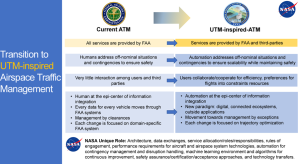
By Philip Butterworth-Hayes
The September 2024 Advanced Air Mobility (AAM) Symposium organised by the International Civil Aviation Organization (ICAO) in Montreal was for the world’s aviation regulatory community a landmark event. For years, aviation regulators have struggled to agree on whether AAM is a revolution or an evolution of the current aviation system. For some, the introduction of escalating levels of autonomy, electric or hydrogen propulsion and digitisation will require a complete overhaul of the regulatory system and the flight rules which underpin every aircraft operation. For others, these are merely evolutions of the current system, requiring adaption rather than complete re-writes of the rules..
For the world’s regulators, UTM is only part of a much wider challenge of digitization of airspace management at all flight levels.
In June 2023 NASA launched its Sky For All vision of a future integrated air traffic management system connecting low level airspace with near-space operations. At the heart of this concept is the idea of a new set of flight rules, Digital Flight Rules, which will introduce automation into the air traffic management system through the integration of UAS traffic management (UTM) concepts of operation into the current air traffic management network

The concept has been broadly welcomed. Standards organisation RTCA wrote its own white paper on the issue Forum for Digital Flight: Enabling Future Operational Concepts in the National Airspace System for All Airspace Users agreeing with the overall concept.
It was this concept of evolving current flight rules to effectively digitize lower airspace ATM operations to integrate drones, eVTOLs, personal flying vehicles and other new lower airspace entrants, which sparked some of the most important conversations at the ICAO Montreal event.
According to Robin Garrity, Senior External Affairs Officer, Single European Sky ATM Research (SESAR) 3 Joint Undertaking, speaking in Montreal: “We can still use IFR and VFR but we can update them to make them more responsive by increasing automation, so there’s a greater level of data exchange, making flight planning faster and more flexible.” Changing the current system of flight rules will require many years of work, he suggested, which will not be needed as current flight rules already have considerable flexibility. He cited the example of the airspace architecture redesign around Milan airport, a Class A airspace, where new low-level IFR routes for helicopter operations supported by appropriate communications, navigation and surveillance/ATM (ATM) systems had been designed to provide approaches into the airport well clear of fixed wing activities.
Some early work has been undertaken by SESAR Concept of Operations for EuRopean UTM Systems (CORUS) researchers to examine how a low-altitude digital IFR system might work. The concept has not yet been fully defined, so some more work is needed there. It will require some major changes to legacy ATC systems and procedures – the routine elements of separation will be provided by a machine rather than a human, with the controller only intervening in exceptional situations which the automation system has not been designed to handle – and there will a cost involved in digitization and automating and CNS/ATM system to manage these operations. On the benefit side, there will be no need for new flight rules, all the pilot needs to do is follow the plan and clearances, and it will allow for optimisation of the traffic and proactive deconfliction. Within this concept, the controller managing an IFR flight should (generally) not be able to tell whether the pilot is on board the aircraft or remote, nor to what extent the piloting is automatic. Likewise, an IFR pilot should not be able to tell which part of the ATC service is being delivered by software and which is delivered by a human.
There would also have to be some realignment of the certification rules around air navigation service providers (ANSPs) and UTM/U-space service providers (USSPs), as this degree of ATM scale of operation is more of an ANSP than a USSP role.
There is a sudden urgency for resolving these challenges as the rapid advance of AAM is overtaking many of the “crawl, walk, run” UTM development schedules which States had been planning. Early trials of multiple operators flying BVLOS drone missions in the same airspace are now underway to test automated detect-and-avoid, communications and flight plan deconfliction tools. But before the results of these trials can be fully taken on board, airspace planners in Gulf States are now having to design operational UTM systems to manage a range of passenger-carrying operational vehicles flying in close proximity, with varying performance characteristics including piloted, remotely piloted and autonomous flight control systems.
For many in the industry the solution to unblocking the regulatory bottlenecks around low level airspace is to give industry a much greater role in progressing low-level airspace management concepts. In the US Federal Aviation Administration (FAA)’s concept of UTM the role of third-party suppliers as airspace managers is fundamental.
“Industry is responding…in a way I don’t think necessitates a complete overhaul,” said Matthew Satterly, Head of Global Policy and Acting Head of Government & Community Affairs for Europe, at Wing, speaking at the Montreal event. “We were segregated from controlled airspace as UAS operators – industry proposed the Low Altitude Authorization and Notification Capability (LAANC) airspace authorisation model now we have eliminated that segregation. Industry was segregated from operating BVLOS near each other; in the past year industry has created a whole interoperability paradigm to allow strategic deconfliction in shared airspace.”
So is data sharing by industry, based on bottom-up industry developed standards, a possible alternative to lengthy and complex top-down rule making by aviation authorities? No – at least not a State level. That would be a revolution which the world is possibly not quite ready for – but it was for the first time on the table for serious discussion among low-level eco-system developers looking to create a limited UTM/U-space area within a city or port.
(Image: Shutterstock)

